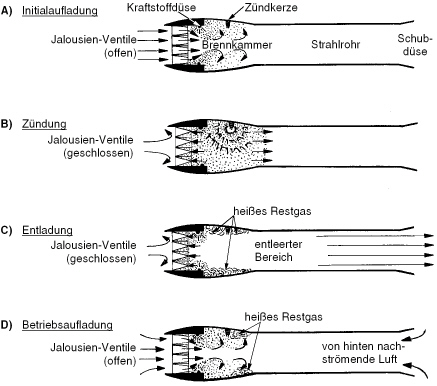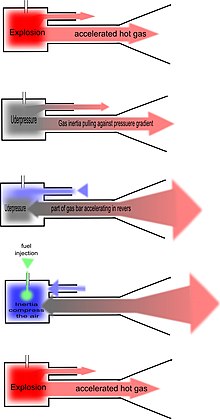Detonator jet engine

The detonation jet engine or pulse jet engine ( English Pulsejet ), z. Sometimes also known as a pulse tube , pulse thrust tube or pulse engine , it is a jet engine . It can also be operated at low flight speeds and when stationary.
history
The historical German names for this drive are Schmidt-Rohr , Argus-Rohr or Argus-Schmidt-Rohr , named after the Berlin engine company Argus and the Munich inventor Paul Schmidt . The Argus Schmidt tube of the Argus As 014 type was the drive for the "flying bombs" Fieseler Fi 103 (V1) used in World War II . The advantage of this drive concept lies in the simple and inexpensive manufacture, the main disadvantage in the short service life of the flutter valves (approx. 15 to 60 minutes), which are exposed to high thermal loads.
Working method
Pulse jet engines work intermittently (pulsating, non-continuous). The general working principle, which can be divided into four phases A) to D) , is shown in the illustration on the right.
- A pulsed engine is started when fresh air enters the engine through the leaf spring inlet valves (flutter or louvre valves) and this is mixed with fuel in the combustion chamber - also known as the initial state → state A).
- A spark plug ignites the fuel-air mixture, and the combustion generates a rapid increase in pressure. This closes the shutter valves (the pressure behind them is greater than in front of them) → state B) .
- The expanding gas is emptied through the push tube to the rear → state C) . After the overpressure has been reduced, the gas flow does not stop immediately due to its inertia, but creates a slight underpressure in the combustion chamber → state D) .
- The negative pressure in the combustion chamber now opens the louvre valves again and new fresh air draws in. At low airspeed, there may also be a slight backflow of the burned gas and / or a subsequent flow of fresh air from behind - condition D) . When fuel is injected again, the process starts again in the engine: The fresh air / fuel mixture ignites (without external ignition) on the hot residual gases D) and on the hot pipe wall; the rapid pressure increase of the combustion closes the shutter valves again → state B) .
Regardless of whether fuel is injected continuously or only when fresh air is available, the gas mixture ignites periodically as soon as it is ignitable (sufficient fresh air and fuel available), since hot residual gases or the hot pipe wall always provide sufficient ignition energy.
Both the return of the flame and the drawing in of fresh air ("from behind") at the exhaust / thrust pipe can significantly influence the performance (thrust). In addition, part of the gas mass flows off to the rear during the filling phase and during combustion, since the engine is always open to the rear. The fresh gas mixture ignites periodically without external ignition on the hot residual gases and on the hot pipe wall.
When the engine is started, the pulsating engine process is usually supplied with fresh air by blowing in compressed air. Sometimes the engine and aircraft are also moved through the air on a launch catapult , and the airflow provides fresh air. However, the engine can also be put into operation without compressed air, only with the help of fresh air induction (due to the specific design of the fuel supply for larger engines).
Characteristic of pulse jet engines are the great noise development (which is often expressed in a deep humming tone), the high fuel consumption, high wall temperatures (~ 1000 ° C, depending on the engine design and material thickness, red-orange and even steel glowing yellow ) and a very short running time due to the limited service life of the flutter valves, so that they are unsuitable for manned aircraft to this day.
A pulse jet engine generally works in acoustic resonance between the combustion chamber and the discharge pipe, which corresponds to the geometrical dimensions of the pipe sections involved.
application
Probably the best-known use of this engine design was to drive the Fieseler Fi 103 (V1) in the late phase of World War II . At the beginning of the 1950s, Ford produced several "Fieseler offshoots" in series production in the USA .
Nowadays these engines are sometimes used to power model airplanes , but are banned in most European countries due to the loud operating noise. But military use in drones is also being tested through ongoing further developments.
Valveless engines
As early as the 1940s and 1950s, there were extensive studies and attempts to build valveless deflagration jet engines. These went back to the fluidic valves that Nikola Tesla had designed in the 1920s. Here the flutter valves are replaced by "aerodynamic valves", i. In other words, there are no moving parts at all, the engine consists essentially only of waisted pipe sections. The “inlet valve” is simply a piece of pipe that offers more resistance to the deflagration expansion than the jet pipe and thus creates a preferred direction.
Examples are the “Escopette” and “Ecrevisse” from SNECMA or the American designers Lockwood and Hiller (“Lockwood (-Hiller) type jet engine”). From the mid-1950s, however, these approaches were finally superseded by solid and liquid propellant rockets , ramjets or jet engines .
Pulse Detonation Engine
A number of researches are currently being carried out again in the field of valveless detonation jet engines, in particular on those in which the combustion process does not take the form of a deflagration but rather a much more intense detonation . This construction, also called pulse detonation engine ( PDE ), promises not only the high speeds of a supersonic ramjet engine but also a higher degree of efficiency in fuel conversion, since an explosive combustion is more productive than a continuous one. The complex thermodynamic conditions during combustion are difficult to calculate using flow simulation.
PDE operated at a high frequency (> 1000 Hz) promise better fuel efficiency even at low speeds, which in times of rising energy prices means considerable savings compared to turbojets . This is why Pratt & Whitney and General Electric have now started their own research on PDE technology.
One variant is PDRE - Pulsed Detonation Rocket Engine - which, like conventional liquid fuel rockets, mix oxidizer and fuel, but do not burn it continuously, but also detonate it in pulses. The possible gain in efficiency of 5 to 10 percent would be very attractive in view of the high costs of space transport of payloads.
See also
- Jet engine
- Types of aircraft engines
- Detonation vs. Deflagration (" deflagration ")
- List of aircraft engines
Web links
- History, technology and photos, etc. a. on PDE and PDRE ( Memento from April 10, 2012 in the Internet Archive )
- Homemade pulse engines
- Private site with a lot of information about model airplane pulses and their construction
- Side with building plans and detailed information, including valveless engines (English)
- Death Rattler - a machine art project powered by Pulsejet
Individual evidence
- ↑ For example: Aerodynamic Valves: US Patent 2825203 Filing date: Jun 24, 1952
- ↑ Ramjet, Scramjet & PDE an Introduction ( Memento of November 18, 2006 in the Internet Archive ) (French)

